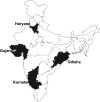Epidemiology of Plasmodium vivax Malaria in India
- PMID: 27708188
- PMCID: PMC5201217
- DOI: 10.4269/ajtmh.16-0163
Epidemiology of Plasmodium vivax Malaria in India
Abstract
Historically, malaria in India was predominantly caused by Plasmodium vivax, accounting for 53% of the estimated cases. After the spread of drug-resistant Plasmodium falciparum in the 1990s, the prevalence of the two species remained equivalent at the national level for a decade. By 2014, the proportion of P. vivax has decreased to 34% nationally, but with high regional variation. In 2014, P. vivax accounted for around 380,000 malaria cases in India; almost a sixth of all P. vivax cases reported globally. Plasmodium vivax has remained resistant to control measures, particularly in urban areas. Urban malaria is predominantly caused by P. vivax and is subject to outbreaks, often associated with increased mortality, and triggered by bursts of migration and construction. The epidemiology of P. vivax varies substantially within India, including multiple relapse phenotypes with varying latencies between primary infection and relapse. Moreover, the hypnozoite reservoir maintains transmission potential and enables reestablishment of the parasite in areas in which it was thought eradicated. The burden of malaria in India is complex because of the highly variable malaria eco-epidemiological profiles, transmission factors, and the presence of multiple Plasmodium species and Anopheles vectors. This review of P. vivax malaria in India describes epidemiological trends with particular attention to four states: Gujarat, Karnataka, Haryana, and Odisha.
© The American Society of Tropical Medicine and Hygiene.
Figures











References
-
- World Health Organization World Malaria Report 2014. 2015. http://www.who.int/malaria/publications/world-malaria-report-2015/en/ Available at. Accessed July 23, 2016.
-
- Directorate of National Vector Borne Disease Control Programme Strategic Plan for Malaria Control in India 2012–2017: A Five-Year Strategic Plan. 2012. http://nvbdcp.gov.in/Doc/Strategic-Action-Plan-Malaria-2012-17-Co.pdf Available at. Accessed July 23, 2016.
-
- Srivastava HC, Kant R, Bhatt RM, Sharma SK, Sharma VP. Epidemiological observations on malaria in villages of Buhari PHC, Surat, Gujarat. Indian J Malariol. 1995;32:140–152. - PubMed
-
- Adak T, Sharma VP, Orlov VS. Studies on the Plasmodium vivax relapse pattern in Delhi, India. Am J Trop Med Hyg. 1998;59:175–179. - PubMed
Publication types
MeSH terms
Substances
LinkOut - more resources
Full Text Sources
Other Literature Sources

